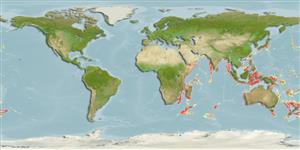Actinopterygii (ray-finned fishes) >
Osmeriformes (Smelts) >
Alepocephalidae (Slickheads)
Etymology: Aulastomatomorpha: Greek, aulos = flute + Greek, stoma = mouth + Greek, morphe = shape (Ref. 45335). More on author: Alcock.
Environment / Climate / Range
Ecology
Marine; bathydemersal; depth range 1717 - 2020 m (Ref. 40779). Deep-water, preferred ?
Indo-West Pacific: Gulf of Oman, Arabian Sea, Bay of Bengal, and Coral Sea.
Size / Weight / Age
Maturity: Lm ? range ? - ? cm
Max length : 28.0 cm SL male/unsexed; (Ref. 40779); 20.4 cm SL (female)
Short description
Morphology | Morphometrics
Dorsal
soft rays
(total): 21;
Anal
soft rays: 33 - 41;
Vertebrae: 52. Head naked, covered with soft, tough skin. Cephalic lateralis system with 5 pores each in the supraorbital, preopercular, and mandibular series and 4 in posttemporal series. No trace of supratemporal commissure. Two pores joined by a short, dark canal on lachrymal on each side of snout above the maxillae. Snout elongate with upper jaw shorter than the lower jaw. Head narrow. Body with small, barely or non-imbricate scale pockets. Branchiostegal rays 5 (?). Pyloric caeca 4 (Ref. 40779).
Found on the continental slope (Ref. 75154).
Life cycle and mating behavior
Maturity | Reproduction | Spawning | Eggs | Fecundity | Larvae
Markle, D.F. and Y.I. Sazonov, 1996. Review of the rare deep-sea genus, Aulastomatomorpha (Teleostei: Salmoniformes), with a discussion of relationships. Copeia 1996(2):497-500. (Ref. 40779)
IUCN Red List Status (Ref. 115185)
CITES (Ref. 94142)
Not Evaluated
Threat to humans
Harmless
Human uses
More information
Age/SizeGrowthLength-weightLength-lengthLength-frequenciesMorphometricsMorphologyLarvaeLarval dynamicsRecruitmentAbundance
ReferencesAquacultureAquaculture profileStrainsGeneticsAllele frequenciesHeritabilityDiseasesProcessingMass conversion
Tools
Special reports
Download XML
Internet sources
Estimates of some properties based on models
Phylogenetic diversity index (Ref.
82805): PD
50 = 1.0000 [Uniqueness, from 0.5 = low to 2.0 = high].
Bayesian length-weight: a=0.00347 (0.00157 - 0.00764), b=3.19 (3.00 - 3.38), in cm Total Length, based on LWR estimates for this (Sub)family-body shape (Ref.
93245).
Trophic Level (Ref.
69278): 3.5 ±0.5 se; Based on size and trophs of closest relatives
Resilience (Ref.
69278): Medium, minimum population doubling time 1.4 - 4.4 years (Preliminary K or Fecundity.).
Vulnerability (Ref.
59153): Moderate vulnerability (43 of 100) .
